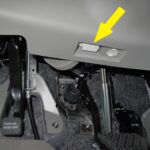Navigating the world of automotive diagnostics can be perplexing, especially when your vehicle throws you a curveball. For owners of certain 1994 and 1995 General Motors vehicles, a common frustration arises when attempting to use standard OBD2 scanners. You might plug in your brand new, off-the-shelf OBD2 scanner, only to find it powers up but refuses to communicate with your car’s computer. This scenario, as one GMC Sonoma owner discovered, isn’t just an isolated incident but a known quirk stemming from a transitional period in automotive technology.
This owner’s experience with a 1995 GMC Sonoma highlights a crucial issue: the presence of an OBD2 port does not automatically guarantee an OBD2 compliant computer system. Despite the OBD2 port being physically present, many 1994 and 1995 GM vehicles, including some Chevrolet and GMC models, were equipped with OBD1 computer systems. This mismatch creates a diagnostic dead-end for typical OBD2 scanners. As the owner recounted, even a Craftsman scanner, designed to read various protocols, failed to establish communication, although it did show attempts at different communication protocols – a somewhat informative but ultimately unhelpful display.
The problem lies in the automotive industry’s shift from OBD1 to OBD2. OBD2 became federally mandated in the United States for all cars manufactured in 1996 and onwards. However, in the years leading up to this mandate, some manufacturers, including GM, began incorporating OBD2 ports into their vehicles as they transitioned their production lines. This resulted in a hybrid situation in some 1994 and 1995 models: the physical OBD2 port was present, likely for ease of assembly or future-proofing, but the underlying computer system and communication protocol remained OBD1.
The owner’s experience further illustrates this with the contrasting success of a mechanic friend using a professional-grade SnapOn scanner. These high-end scanners are often designed with broader compatibility and the ability to detect and adapt to different protocols automatically. This suggests that the SnapOn scanner could identify the OBD1 protocol despite the OBD2 port, and adjust its communication accordingly. This also points to why standard, less sophisticated OBD2 scanners fail – they are programmed to communicate via OBD2 protocols and are not equipped to handle the older OBD1 systems.
Adding another layer of complexity, the emissions sticker on the owner’s GMC Sonoma lacked the OBD2 certification marking. This detail is a significant clue. Vehicles certified as OBD2 compliant are typically marked as such on their emission control information label, usually located under the hood. The absence of this marking on a vehicle with an OBD2 port is a strong indicator of a potential OBD1 system lurking beneath the surface.
For owners facing this OBD1-in-an-OBD2-port dilemma, several solutions exist. The most straightforward approach is to utilize an OBD1 scanner. However, given the OBD2 port on the vehicle, a practical solution involves acquiring an OBD1 to OBD2 adapter cable. This adapter essentially bridges the physical connection difference, allowing an OBD1 scanner to interface with the OBD2 port while communicating with the OBD1 computer system. Alternatively, as the owner considered, creating a custom cable by understanding the pinouts of both OBD1 and OBD2 systems is another, albeit more technical, option.
The frustration voiced by the GMC Sonoma owner regarding potential “intentional bad design” or using “incorrect wiring harnesses” touches upon a valid consumer concern. The incompatibility can indeed lead vehicle owners to dealerships or specialized repair shops equipped with advanced diagnostic tools, potentially incurring higher costs. While a class-action lawsuit, as mentioned, is a drastic measure and likely complex to pursue, the core issue highlights the importance of clear communication and standardized diagnostic interfaces in the automotive industry.
In conclusion, if you own a 1994 or 1995 General Motors vehicle and are struggling to connect with an OBD2 scanner despite having an OBD2 port, the likely culprit is an underlying OBD1 computer system. Before assuming a scanner malfunction or a vehicle issue, investigate whether your vehicle falls into this transitional category. Checking your emissions sticker for OBD2 certification and considering an OBD1 scanner or an OBD1-to-OBD2 adapter are crucial steps in successfully diagnosing your vehicle. Understanding this historical quirk can save both time and money, empowering vehicle owners to navigate the sometimes-confusing landscape of automotive diagnostics and repair.

